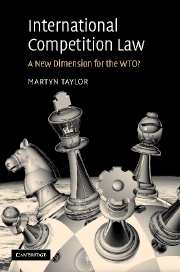Book contents
- Frontmatter
- Contents
- List of tables and figures
- List of abbreviations
- 1 Introduction
- PART I An International Competition Agreement is Desirable
- PART II The WTO Would Provide a Suitable Institutional Vehicle
- PART III The Optimal Form for a WTO Competition Agreement
- 10 What are the optimal objectives and principles for a WTO competition agreement?
- 11 What is the optimal content for a WTO competition agreement?
- 12 What is the optimal structure for a WTO competition agreement?
- 13 Would a WTO competition agreement be politically achievable?
- 14 Conclusion: a plurilateral competition agreement should be incorporated into the WTO
- APPENDIX: Draft negotiating text for a plurilateral WTO competition agreement
- Index
10 - What are the optimal objectives and principles for a WTO competition agreement?
Published online by Cambridge University Press: 17 July 2009
- Frontmatter
- Contents
- List of tables and figures
- List of abbreviations
- 1 Introduction
- PART I An International Competition Agreement is Desirable
- PART II The WTO Would Provide a Suitable Institutional Vehicle
- PART III The Optimal Form for a WTO Competition Agreement
- 10 What are the optimal objectives and principles for a WTO competition agreement?
- 11 What is the optimal content for a WTO competition agreement?
- 12 What is the optimal structure for a WTO competition agreement?
- 13 Would a WTO competition agreement be politically achievable?
- 14 Conclusion: a plurilateral competition agreement should be incorporated into the WTO
- APPENDIX: Draft negotiating text for a plurilateral WTO competition agreement
- Index
Summary
Parts II and III of this book reached a number of conclusions regarding the desirability and theoretical and practical scope for any WTO competition agreement. However, this book has not yet considered whether the WTO would provide the optimal institutional vehicle for any international competition agreement. Part III of this book therefore identifies the optimal form for an international competition agreement.
Chapter 10 of this book has four main sections:
Section 10.1 considers whether the WTO would provide the optimal institutional vehicle for an international competition agreement relative to the most likely alternative institutional vehicles.
Section 10.2 analyses three previous proposals for the incorporation of competition law into the WTO and identifies the respective merits and shortcomings of these proposals. Section 10.2 identifies how the previous shortcomings could be avoided.
Sections 10.3 and 10.4 identify the key objectives and core principles that should guide any WTO competition agreement and the extent to which these would correlate with pre-existing WTO objectives and core principles.
Chapter 10 concludes that the WTO would provide the optimal institutional vehicle for an international competition agreement.
What would be the optimal institutional vehicle for an international competition agreement?
In order to identify whether the WTO would provide the optimal institutional vehicle for an international competition agreement, it is necessary to compare the WTO with the other most likely alternative institutional vehicles.
- Type
- Chapter
- Information
- International Competition LawA New Dimension for the WTO?, pp. 289 - 335Publisher: Cambridge University PressPrint publication year: 2006

